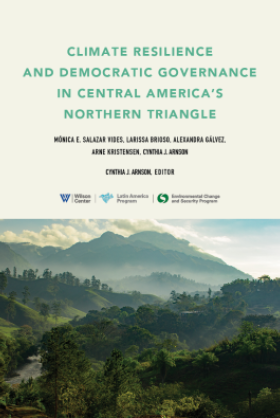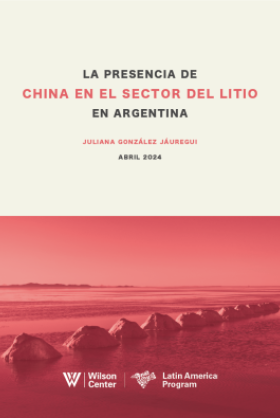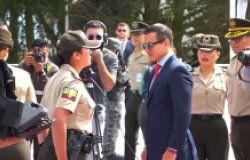The United States and Mexico: Strategic Partners or Distant Neighbors?
6th Floor Flom Auditorium
Overview
Welcome and Introduction
Dr. Cynthia Arnson, Director, Latin America Program
José Antonio Fernández, Chair, Mexico Institute and Chair & CEO, FEMSA
Mr. Roger W. Wallace, Co-Chair, Mexico Institute and Vice President, Pioneer Natural Resources
Opening Remarks
His Excellency Arturo Sarukhan, Ambassador of Mexico to the United States
Moderator: Dr. Andrew Selee, Director, Mexico Institute
Roundtable I: The State of the Relationship
Moderator: Dr. Rossana Fuentes-Berain, Opinion Editor, El Universal
Hon. Jim Kolbe, former Congressman and Senior Advisor, Kissinger McLarty Associates
Mr. José Antonio Fernández, Co-Chair, Mexico Institute and Chair & CEO, FEMSA
Dr. Roderic Ai Camp, Professor, Claremont-McKenna College
Amb. Andrés Rozental, Chair of the Board of Trustees, Mexican Council on Foreign Relations
Dr. Peter Smith, Professor, University of California, San Diego
Cynthia Arnson noted that it is inevitable that Mexico and the United States will always maintain a relationship due to their close geographic proximity and common interests, but the question is how to define and shape that relationship today. José Antonio Fernández added that the United States and Mexico are now much more than neighbors. The two countries are increasingly interdependent, and face common challenges which can only be resolved if they begin to think of the relationship as a strategic partnership. Roger Wallace commended the panel for drawing from one of the most distinguished binational boards of leaders in business and academia.
Andrew Selee stated that the cornerstone of the conference is the idea that Mexico and the United States must move away from only responding tactically on specific issues to thinking strategically about what each wants from the other. Ambassador Arturo Sarukhan argued that the two countries have not reached a strategic relationship, yet nor do they remain the distant neighbors they were once were. The signing of NAFTA ushered in a more strategic era, but the most important bilateral relationship in the world continues to be constrained by its focus on the short term. In order to develop a more strategic relationship, the two countries need to identify what key issues unite them in the way countries of the future European Union identified coal and steel as their points of convergence. He identified common prosperity and common security as these potential strategic issues. He concluded by suggesting that the United States and Mexico need to "stop playing checkers and start playing chess," that is, move from tactical to strategic engagements with each other.
Rossana Fuentes-Berain suggested that the United States and Mexico are living in not only a distant neighborhood, but a rough one. There is no key strategic thinking occurring, and the "coal and steel" of the relationship are not being discussed. She pointed out that the booing against the United States in a soccer game and of Miss USA when she appeared in Mexico only further reflects the extent of the difficulties the two countries face in achieving a strategic partnership.
Jim Kolbe argued that the pivotal change in the relationship was seen as a direct result of NAFTA. The most important impact of NAFTA, Kolbe suggested, has been political rather than economic. He commented that the relationship between the countries has matured since he began attending inter-parliamentary meetings in the 1980s, and now there is more agreement that issues such as drug trafficking and immigration are shared concerns to be addressed jointly.
Andrés Rozental added that the major obstacle that the bilateral relationship faces is a lack of a strategic vision on either side. The United States has clear objectives for its relationship with other countries, but no such one exists for its dealings with Mexico, nor does Mexico have a strategic vision for its relationship with the U.S. Neither government will get what they want from the relationship if they cannot identify what they need. Rozental urged a change of attitude on both sides of the border because the lack of a clear strategic vision is affecting the region's competitiveness.
Roderic Camp detailed contextual qualities that are important to understand when analyzing the U.S.-Mexico relationship. He explained that foreign policy rarely plays any role in Mexican domestic politics, unlike in the United States. In Mexico the three most important policy issues in the past three presidential elections have been personal security, corruption, and economic growth and poverty. He further asserted that the Mexican views presented in conferences such as this one do not express the perspectives of ordinary Mexicans, whose views are commonly overlooked in discussions of the bilateral relationship.
Peter Smith emphasized the need to define the term "strategic partners." In order to approach that relationship, the United States and Mexico must define what that partnership would look like, as well as what its goals and purpose would be. However, he noted that neither government has a clear vision of its role in the global arena, so it would be impossible for them to come up with a joint vision for working together strategically. This can only come once each government decides what it wants its role in the world to be.
José Antonio Fernández argued that the bilateral relationship needs a social agreement to reach a strategic partnership. Because many of the two countries' goals are complementary, Mexico and the United States should work together to develop a shared long-term vision of what can be accomplished jointly. He named the need in the United States for more nurses and Mexico's need for training and better-paying jobs as a potential field for cooperation.
Roundtable II: Creating a New Agenda for the Relationship
Moderator: Ms. Ginger Thompson, Reporter, New York Times
Amb. Jim Jones, former Congressman and Ambassador to Mexico and Chairman, Manatt Jones
Hon. Javier Treviño, Vice President of CEMEX and former Undersecretary of Foreign Affairs
Dr. Susan Kaufman Purcell, Director, Center for Hemispheric Policy, University of Miami
Hon. Carlos Heredia, Advisor to Governor of Michoacán and former Congressman
Hon. Maria Echaveste, President, Nueva Vista and former Deputy Chief-of-Staff, White House
Ginger Thompson commented on the schizophrenic nature of the bilateral relationship and the tendency for each side to develop its opinions in seemingly parallel universes. Even fundamental differences in perspectives, like the U.S. view that Mexicans want to come to the U.S. contrasted by the Mexican opinion that they are forced to, make the relationship very difficult to maneuver.
Regarding the current U.S. debate over immigration legislation, Susan Kaufman Purcell discussed the fragility of the current Senate bill. Even if it passed in the Senate, she explained, it would face great obstacles in the House of Representatives. Neither the Democrats nor the Republicans are united; nor are the interests of business or labor groups. On either side, weak temporary alliances have been forged in the place of traditional ones, meaning any amendment could cause divisions and subsequently cause the bill to fail.
Maria Echaveste analyzed the proposed immigration bill from a Democratic standpoint, arguing that this is a difficult bill to accept because the proposed guest worker program essentially establishes a permanent underclass. Immigration policies ultimately indicate the society's fundamental decision of who is allowed to be American. Despite this drawback, however, she noted that the provisions allowing for legalization make it impossible to walk away from the current debate.
Carlos Heredia asserted that a fundamental piece of the immigration agenda for Mexican immigrants is the issue of mobility. If an immigrant can leave the United States to visit an ailing relative in Mexico and then return back, a proposed immigration bill is acceptable. If it limits that mobility, Mexican immigrants will not be satisfied with the legislation. The real question, however, is how can Mexico become more competitive by challenging existing monopolies.
Javier Treviño focused on reforms Mexico needs to take to move the two countries towards a more strategic alliance. The first step is that Mexico must recognize that the three crucial bilateral issues of migration, security, and competiveness are all intricately related. The imperatives of creating better-paying jobs, doing away with monopolies, and confronting the drug crisis all must be addressed in order to address the crucial bilateral issues and improve the relationship.
Ambassador Jim Jones argued that the key solution to moving towards a more strategic relationship is improving each public's understand of the other. He recommended creating a massive exchange problem with different divisions, such as education, sports, and political exchanges. Mexicans would go to the United States to explain, and Americans would go to Mexico to listen. Through this, the two nations would develop a deeper understanding that would pave the way for a more effective dialogue.
Hosted By

Mexico Institute
The Mexico Institute seeks to improve understanding, communication, and cooperation between Mexico and the United States by promoting original research, encouraging public discussion, and proposing policy options for enhancing the bilateral relationship. A binational Advisory Board, chaired by Luis Téllez and Earl Anthony Wayne, oversees the work of the Mexico Institute. Read more
Thank you for your interest in this event. Please send any feedback or questions to our Events staff.










